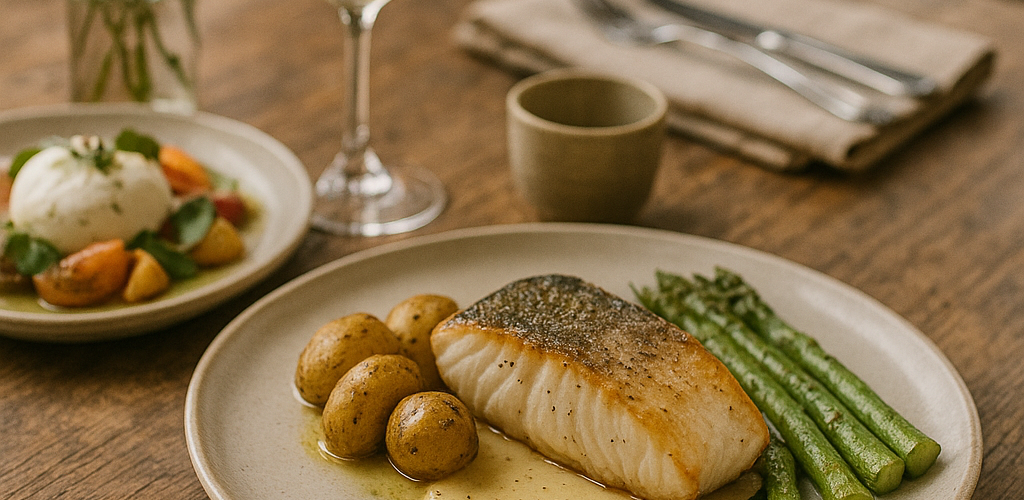Farm-to-Table Dining Experience: A Complete Review

We arrived at the farm just as the late afternoon sun painted the fields gold. The gravel driveway crunched under the car tires, and the scent of fresh earth mixed with the faint aroma of herbs drifting from a nearby garden. It felt like stepping into another world — one where time slowed down and food had a story to tell before it reached the plate.
The dining venue sat in the heart of the property, surrounded by rows of leafy greens, fruit trees, and a modest barn converted into a rustic yet elegant dining hall. Wooden beams arched over the ceiling, and strings of warm lights stretched across the room. Tables wore linen runners, small vases of freshly picked wildflowers, and handmade ceramic plates. We immediately knew this would not be a rushed, transactional meal; it would be an immersive journey from soil to plate.
A Warm Welcome: Meeting the Team Behind the Experience
The host greeted us with genuine warmth. She explained that the evening would begin with a guided tour of the farm before we sat down to eat. We joined a small group of other guests, each as eager as we were to learn about the farm’s practices and taste its harvest.
Our guide, a young farmer named Alex, spoke with passion and pride as he led us down rows of vibrant vegetables. He showed us the carrot beds, pulling one up to reveal its deep orange hue. He let us taste a cherry tomato straight off the vine — still warm from the sun, its flavor burst with sweetness and acidity that supermarket tomatoes could never match.
We visited the herb garden next. The scent of basil, rosemary, and mint filled the air. Alex encouraged us to rub the leaves between our fingers and inhale deeply. He pointed out the composting area, the beehives buzzing in the distance, and the greenhouse where tender seedlings grew under careful watch. By the time we completed the tour, we had touched, smelled, and tasted the very ingredients that would appear on our plates later.
The Philosophy: More Than Just a Meal
The chef, Maria, joined us before dinner service began. She explained her philosophy in simple yet powerful terms: respect for the land, transparency in sourcing, and honoring the seasons.
She told us that every dish on tonight’s menu featured ingredients harvested within a 50-mile radius, most of them from this very farm. The bread came from a nearby artisan baker who used locally milled flour. The cheese came from a family-owned dairy just down the road. The wines came from a vineyard whose owners she knew personally.
Maria emphasized that “farm-to-table” wasn’t just a marketing phrase here. It represented a relationship between farmers, producers, and diners. Every link in that chain mattered, and tonight we would taste the difference.
The Menu: A Celebration of the Season
We sat down at our table, and the menu read like a love letter to spring. Instead of listing dishes in complex culinary jargon, it described ingredients and origins.
Amuse-Bouche:
- A bite-sized crostini topped with whipped goat cheese, honey from the farm’s hives, and microgreens grown in the greenhouse.
Starter:
- Spring pea soup with mint, served chilled, finished with a swirl of crème fraîche.
Second Starter:
- Heirloom tomato salad with burrata, basil, and aged balsamic reduction.
Main Course Options:
- Pan-seared trout from the local river, served with roasted baby potatoes, charred asparagus, and lemon butter sauce.
- Grass-fed beef tenderloin with wild mushroom jus, mashed parsnips, and sautéed kale.
Dessert:
- Strawberry shortcake with vanilla bean cream and mint syrup.
The server explained that the menu changed weekly — sometimes daily — depending on what the farm harvested that morning.
The First Bite: Amuse-Bouche
The amuse-bouche arrived first, and from that single bite, we felt the farm’s essence. The goat cheese tasted creamy and tangy, balanced perfectly by the sweetness of the honey. The microgreens added a peppery freshness. Each element told its own story but harmonized on the palate.
Starter One: Spring Pea Soup
The chilled pea soup arrived in a deep bowl, its vibrant green color a visual promise of freshness. The first spoonful confirmed it — sweet, earthy peas paired beautifully with bright mint. The crème fraîche added a creamy tang that made the soup both refreshing and indulgent.
Maria later told us she had shelled those peas herself that morning, and the mint came from the patch we had visited during the tour. That connection made the soup taste even better.
Starter Two: Heirloom Tomato Salad
Next came the heirloom tomato salad. Thick slices of tomatoes in shades of red, yellow, and even deep purple covered the plate. They tasted sun-ripened and impossibly juicy. The burrata oozed rich cream, and the basil — freshly picked that day — released its fragrance with every bite. The aged balsamic added depth without overpowering the natural sweetness of the tomatoes.
Main Course: Pan-Seared Trout
I chose the trout for my main course. Its skin crackled under my fork, revealing tender, flaky flesh inside. The lemon butter sauce enhanced the fish’s delicate flavor without masking it. The roasted baby potatoes had crispy edges and fluffy centers, while the charred asparagus added a subtle smokiness.
I could almost picture the trout swimming in the local river just days before, and that freshness showed in every bite.
Main Course: Grass-Fed Beef Tenderloin
My companion ordered the beef tenderloin. The meat arrived perfectly seared, with a blushing pink center. The wild mushroom jus gave it earthy complexity, while the mashed parsnips provided a naturally sweet counterpoint. The sautéed kale brought a slight bitterness that balanced the richness of the beef.
He declared it one of the most flavorful steaks he had ever eaten — not because it was overly seasoned, but because the quality of the beef spoke for itself.
Dessert: Strawberry Shortcake
Dessert felt like a celebration of spring. The shortcake had a crumbly texture that absorbed the juices from the macerated strawberries. The vanilla bean cream tasted luxurious, and the mint syrup provided a bright finish.
Maria explained that the strawberries had been picked less than two hours before dinner service. Knowing that made the dessert taste even sweeter.
Service: Attentive and Personal
Throughout the evening, the staff moved with a blend of professionalism and warmth. They anticipated our needs without hovering, and they spoke knowledgeably about each dish. When we asked questions, they answered with enthusiasm, clearly proud of the farm and its mission.
Atmosphere: Rustic Elegance
The dining room had a rustic charm enhanced by modern touches. Candles flickered on the tables, and soft acoustic music played in the background. Large windows offered views of the fields, which glowed under the setting sun and later under a blanket of stars.
By the time dessert ended, the night sky had deepened to indigo, and the only sounds were laughter from other tables and the gentle hum of crickets outside.
Beyond the Plate: Educational and Emotional Impact
This experience offered more than just a meal; it created a connection to the source of our food. We left understanding how much work and care went into every ingredient. We saw firsthand how sustainable farming practices protected the soil, conserved water, and promoted biodiversity.
Eating at a farm-to-table restaurant felt different from dining anywhere else because the journey of the food was part of the story. Each bite carried the freshness of the fields and the dedication of the people who worked them.
Value for Money
Farm-to-table dining isn’t inexpensive, but here, the value matched the price. The quality of the ingredients, the artistry of the cooking, and the immersive nature of the experience justified every dollar. This was not just dinner; it was a four-hour exploration of flavor, sustainability, and hospitality.
Final Thoughts and Recommendation
Our farm-to-table dining experience left a lasting impression. We didn’t just eat; we participated in a celebration of local agriculture and seasonal cooking. The freshness of the ingredients, the skill in the kitchen, and the personal connections made it unforgettable.
I recommend this experience to anyone who values food with integrity, enjoys learning where their meal comes from, and wants to savor flavors at their peak. Go hungry, go curious, and leave with a deeper appreciation for the land and the people who nurture it.













